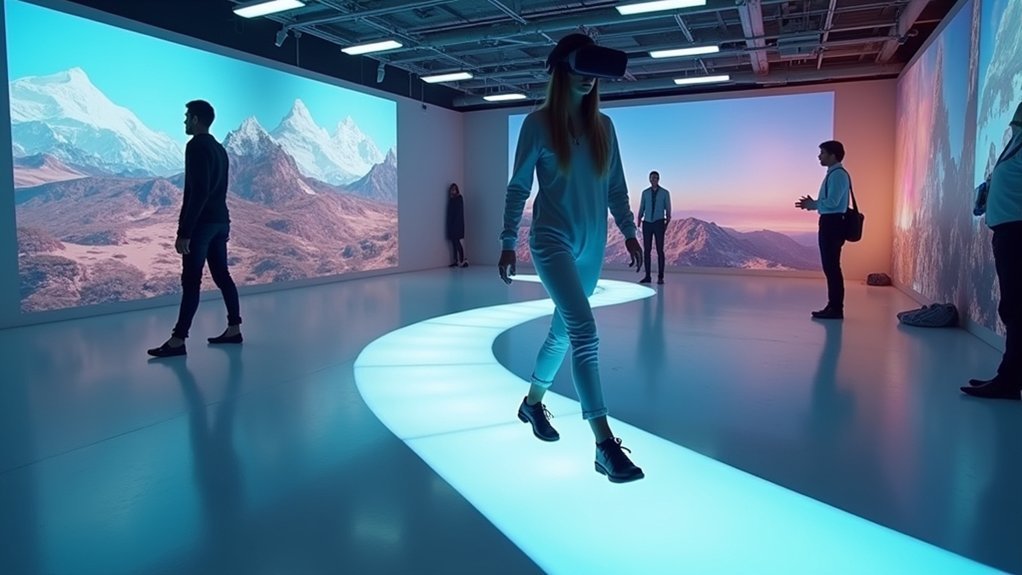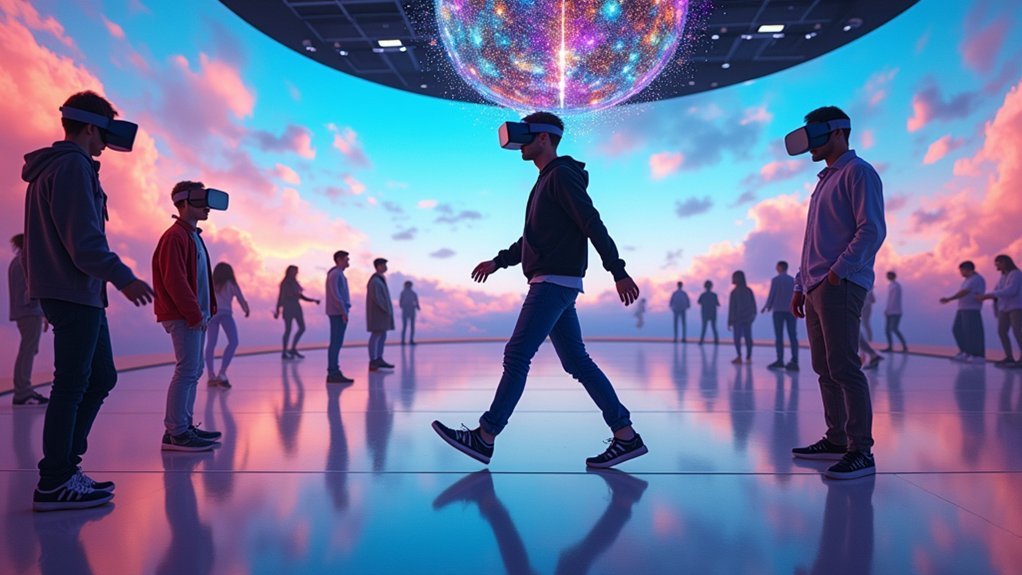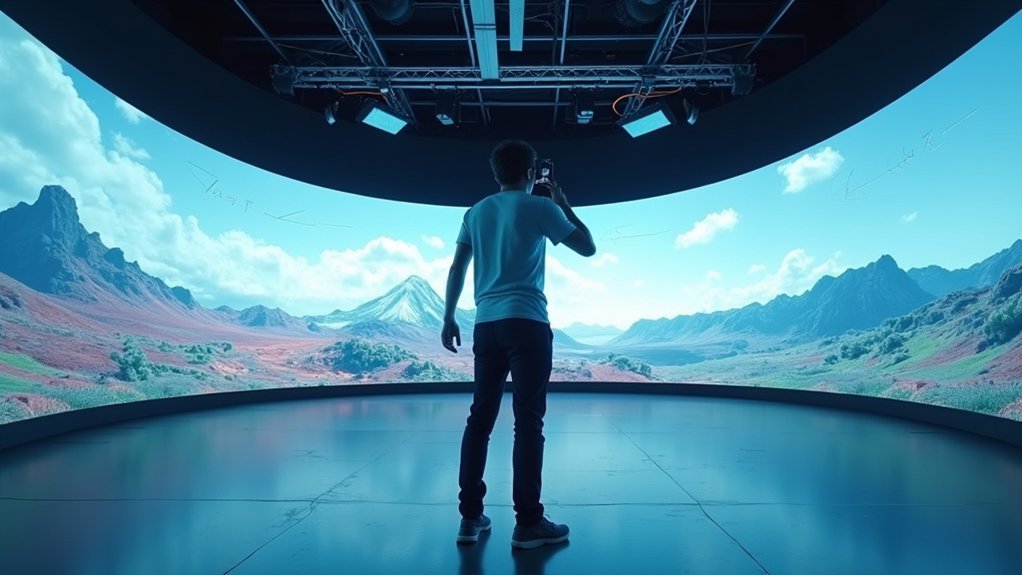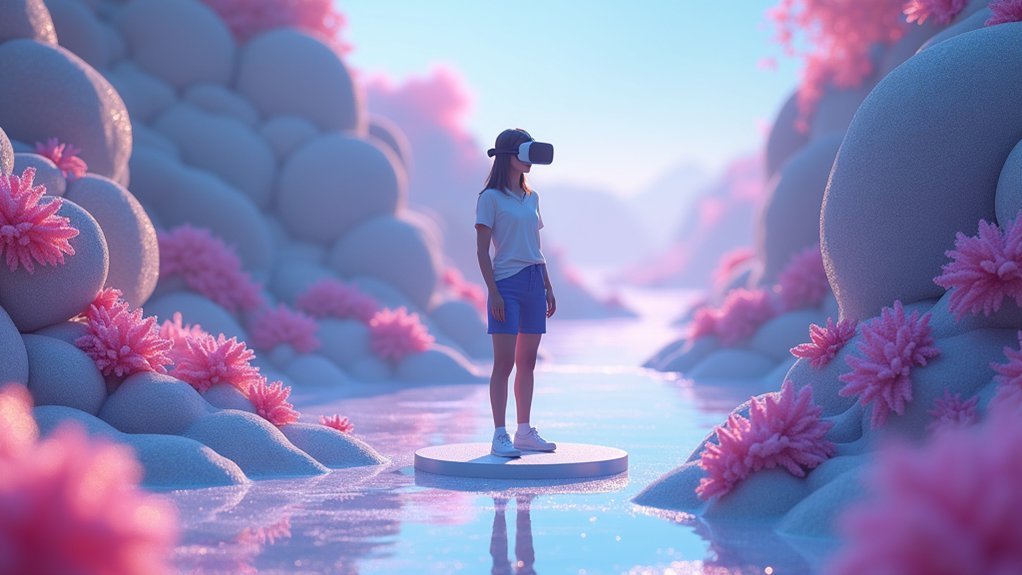You’ll master redirected walking by implementing translation, rotation, and curvature gains that manipulate your movement perception below detection thresholds. These techniques use artificial potential fields to guide you through unlimited virtual spaces within small physical areas. Successful RDW systems integrate seamless HMD tracking, real-time boundary management, and adaptive redirection algorithms that prevent VR sickness while maintaining immersion. Understanding these core principles will reveal advanced multi-user coordination and optimization strategies for your VR implementations.
Understanding the Core Principles of Redirected Walking Technology

While traditional VR systems confine you to small physical spaces, Redirected Walking (RDW) technology breaks these barriers by cleverly manipulating how your movements translate into the virtual world. This technique exploits your visual perception to make you believe you’re walking straight while actually steering you along curved paths within your available area.
RDW operates through two fundamental mechanisms: rotational gains that introduce subtle turns during movement or stillness, and translation gains that adjust your perceived walking speed. These modifications remain below your detection threshold, maintaining immersion while maximizing spatial efficiency.
Advanced implementations utilize Artificial Potential Fields to navigate complex environments dynamically. This approach guides you through non-convex spaces without requiring predetermined walkable zones, enabling natural exploration throughout expansive virtual reality environments that far exceed your actual physical space limitations.
Key Components of Successful RDW Implementation
You’ll need to master three essential components to implement RDW effectively in your VR system.
First, you must create accurate virtual space mapping that corresponds to your physical boundaries while maximizing the explorable area.
Then, you’ll align user interactions with the virtual environment while managing safety boundaries that prevent collisions with real-world obstacles.
Virtual Space Mapping
Before your users can seamlessly navigate virtual environments, you must establish precise mapping between physical and virtual spaces that forms the foundation of any successful RDW system.
This virtual space mapping process requires you to accurately define how your physical boundaries correspond to virtual terrain, ensuring safe user navigation throughout the experience.
Your mapping strategy should incorporate translation gain, rotation gain, and curvature gain techniques to maintain immersion while keeping users within safe physical limits.
You’ll need to implement artificial potential fields when working with non-convex or dynamic spaces, as these allow exploration without requiring pre-defined walkable areas.
This flexibility becomes essential when designing complex virtual environments that don’t mirror your physical space’s layout, enabling more creative and expansive VR experiences.
User Interaction Alignment
Once you’ve established your virtual space mapping, maintaining precise alignment between user interactions becomes critical for preserving the illusion that physical and virtual movements are identical.
Your Redirected Walking system must seamlessly coordinate user interaction patterns across physical and virtual spaces to prevent breaking immersion.
Effective alignment requires these four essential elements:
- Real-time movement synchronization – Your system tracks user position and orientation continuously, ensuring virtual actions mirror physical movements precisely.
- Dynamic Gain Application adjustments – Rotational, translational, and curvature gains adapt instantly to maintain natural interaction flow.
- Multi-user coordination protocols – When multiple users share virtual environments, their interactions must remain coherent across all participants.
- Object interaction consistency – Virtual objects respond predictably regardless of redirection techniques, maintaining believable physics and spatial relationships.
Safety Boundary Management
While your RDW system creates convincing spatial illusions, it must prioritize user safety above all else through robust boundary management protocols. Effective safety boundary management prevents collisions with real-world obstacles while users navigate expansive virtual environments.
The Steer-to-Center (S2C) method guides users toward your tracking area’s center, reducing boundary violation risks. You’ll need continuous monitoring of the user’s position and orientation to implement real-time redirection adjustments that maintain seamless physical-virtual shifts.
Integrating an artificial potential field (APF) enables dynamic redirection gain modifications based on proximity to boundaries. This approach guarantees users stay within safe zones while preserving immersion.
Successful boundary management notably reduces VR sickness incidents and enhances overall user experience by maintaining comfortable, safe navigation throughout extended VR sessions.
Artificial Potential Fields and Vector-Based Navigation
As virtual reality environments become increasingly complex, artificial potential fields (APFs) emerge as a sophisticated solution for guiding users through redirected walking systems. This technology creates dynamic maps that update based on your movements, allowing seamless exploration of uncharted areas within virtual environments.
APFs revolutionize Redirected Walking (RDW) by transforming how you navigate non-convex and dynamic spaces:
- Obstacle Avoidance: High potential areas form at boundaries and obstacles, naturally steering your user movement away from hazards.
- Path Efficiency: Negative gradients compute redirection gains, guiding you along efficient routes through complex terrain.
- Dynamic Mapping: Real-time updates adapt to your position, ensuring accurate navigation in changing environments.
- Enhanced Interactions: Vector-based navigation improves user-to-user and user-to-object interactions, enriching social VR experiences.
Multi-User RDW Systems for Collaborative Virtual Environments

When multiple users share the same virtual environment, traditional redirected walking systems break down because they can’t coordinate physical movements between participants whose real-world positions don’t match their virtual locations. Multiuser redirected walking addresses this challenge by enabling direct contact and meaningful user interactions within collaborative virtual environments.
| Technique | Primary Focus | Key Advantage |
|---|---|---|
| S2OT | Single-user optimization | Enhanced individual navigation |
| MS2OT | Multi-user coordination | Synchronized group movements |
| APF Integration | Dynamic exploration | Non-convex space navigation |
You’ll find that artificial potential fields revolutionize these systems by providing dynamic frameworks for multiple participants. Recent algorithms incorporating artificial vector potentials notably improve accuracy in user-to-user interactions, creating more immersive collaborative experiences where participants can naturally engage with each other and virtual objects simultaneously.
Gain Manipulation Techniques for Seamless Movement Redirection
You’ll master seamless movement redirection through three core gain manipulation techniques that form the foundation of effective RDW systems.
Translation gain methods let you control how users perceive their linear movement speed, while rotation gain control manages their turning sensations during both active rotation and moments of stillness.
Curvature gain applications enable you to guide users along curved virtual paths while they’re walking straight in physical space, creating the illusion of natural navigation without detection.
Translation Gain Methods
Translation gain methods represent one of the most effective approaches to redirected walking, allowing you to traverse expansive virtual worlds within the confines of a small physical space.
These techniques manipulate your perceived walking speed by altering linear movement velocity, creating the illusion you’re covering greater distances than you actually are in real environments.
Key implementation strategies include:
- Dynamic Speed Adjustment – Real-time calibration based on your movement patterns and environmental boundaries
- Collision Prevention – Subtle redirection away from physical obstacles while maintaining natural locomotion
- Seamless Integration – Imperceptible speed modifications that preserve immersion without causing disorientation
- Continuous Flow Maintenance – Uninterrupted movement sequences that enhance user experience and spatial presence
Proper calibration guarantees translation gains remain undetectable while maximizing your explorable virtual territory.
Rotation Gain Control
While translation gains modify your forward movement speed, rotation gain control manipulates your turning movements to achieve even more sophisticated redirection in virtual environments.
This redirected walking (RDW) technique applies subtle rotational adjustments, typically around 15 degrees per second, whenever you’re stationary or turning naturally.
You won’t consciously notice these manipulations because they occur below your perceptual threshold. The system cleverly redirects your path away from physical boundaries while you maintain the sensation of natural walking throughout expansive virtual reality (VR) spaces.
When combined with translation and curvature gains, rotation gain control creates an extensive locomotion solution.
This seamless integration keeps you engaged and immersed, allowing you to explore vast virtual worlds while safely remaining within your designated play area without breaking presence or requiring teleportation.
Curvature Gain Applications
Although you believe you’re walking in a perfectly straight line, curvature gain subtly guides you along curved paths that keep you safely within your physical play space.
This sophisticated redirected walking (RDW) technique manipulates your trajectory without conscious awareness, creating seamless navigation through expansive virtual environments (VEs).
When implemented effectively, curvature gains enhance user comfort by preventing collisions while maintaining natural movement sensations.
Key applications include:
- Collision Prevention – Automatically steers you away from physical boundaries before contact occurs
- Space Optimization – Maximizes exploration potential within limited room-scale areas
- Immersion Enhancement – Maintains believable movement without breaking presence in VEs
- Multi-gain Integration – Combines with translation and rotational gains for thorough movement redirection
You’ll experience fluid navigation that feels completely natural while the system intelligently manages your physical positioning.
Target Orientation Calculation Methods and Applications
When you’re implementing redirected walking systems, calculating the target orientation becomes the foundation that determines where users should physically face to maintain their position within tracked boundaries while exploring unlimited virtual worlds.
This critical component of Redirected Walking (RDW) guarantees you can navigate expansive virtual environments without collision or spatial limitations.
Research shows that 54.5% of RDW techniques employ steering target orientation calculation, making it the most prevalent approach in user redirection strategies.
You’ll find that 32.1% of methods specifically combine steering target orientation calculation with reactive gain application for ideal results.
Overcoming Physical Space Limitations With Advanced Algorithms

You’ll find that multi-user RDW solutions transform how multiple people share the same physical space while experiencing expansive virtual worlds together.
When you implement artificial vector field algorithms, you’re fundamentally creating invisible guidance systems that dynamically steer users away from boundaries and toward safe zones.
These advanced techniques let you maximize your available room-scale area while maintaining natural walking experiences for everyone involved.
Multi-User RDW Solutions
While traditional RDW systems work well for single users, implementing them in multi-user environments creates complex coordination challenges that require sophisticated algorithmic solutions.
You’ll encounter mismatched coordinates between real and virtual spaces that complicate user interaction scenarios. Existing Redirected Walking (RDW) methods haven’t adequately addressed these coordination challenges, focusing primarily on collision avoidance rather than enabling meaningful user-to-user interaction.
Recent developments address these limitations through:
- Multiuser-Steer-to-Optimal-Target (MS2OT) algorithms that optimize multi-user navigation efficiency
- Artificial vector potentials (AVF) for precise orientation guidance and interaction support
- Enhanced coordination systems that facilitate seamless user-to-user interactions
- Validated simulation studies demonstrating improved accuracy in both object and user interactions
These innovations transform multi-user RDW from basic collision avoidance into thorough interaction management systems.
Artificial Vector Field Implementation
Though traditional RDW systems struggle with precise spatial coordination, Artificial Vector Field (AVF) implementation revolutionizes how you navigate complex virtual environments by creating dynamic force-like guidance systems.
The artificial potential field methodology aligns your physical position with virtual-space coordinates, ensuring seamless movement without jarring redirections.
AVF-RDW prevents unintended manipulations when you’re not oriented toward targets, applying rotational gain even during slight movements. This optimization enhances user interactions with objects and other participants in shared spaces.
However, the vector field’s effectiveness decreases with distance from coordinate centers, requiring additional field components for thorough guidance.
Simulation studies validate AVF-RDW’s superior accuracy in facilitating natural user interactions among multiple participants, demonstrating its potential for transforming social VR experiences through precise spatial coordination.
VR Sickness Prevention Through Optimized Redirection Strategies
When over 60% of VR users experience motion sickness, implementing strategic redirection techniques becomes essential for creating comfortable virtual experiences. Optimized redirected walking systems greatly reduce VR sickness while maintaining immersive gameplay through carefully calibrated movement algorithms.
These optimization strategies enhance user engagement by seamlessly blending physical and virtual locomotion:
- Virtual nose integration – Adding a subtle nose reference point provides visual stability and reduces disorientation during movement changes.
- Adaptive redirection thresholds – Dynamically adjusting turn gains based on individual sensitivity levels minimizes motion conflicts.
- Space Sense enhancement – Leveraging Meta Quest 2’s spatial awareness features maintains real-world orientation during virtual navigation.
- Progressive exposure protocols – Gradually increasing redirection intensity allows users to build tolerance while preventing overwhelming sensations.
These combined approaches achieve approximately 50% real running sensation while considerably reducing motion-related discomfort.
Real-Time Performance Optimization for RDW Systems
As VR applications demand increasingly complex interactions, your redirected walking system’s performance becomes the determining factor between immersive experiences and jarring disruptions.
Real-time performance optimization for Redirected Walking (RDW) systems requires algorithms that minimize latency while maintaining seamless environmental transformations. You’ll benefit from implementing artificial vector potentials (AVF) to dynamically adjust user orientation, ensuring responsive interactions during movement.
Optimized RDW algorithms with artificial vector potentials ensure minimal latency and seamless environmental transformations for responsive VR interactions.
Integrating SLAM technology enhances your system’s reliability by enabling real-time adjustments to dynamic obstacles and environmental changes. You must continuously monitor performance metrics, particularly response times and user comfort levels, to refine your RDW implementation.
Simulation studies confirm that optimized algorithms greatly improve interaction accuracy between users and virtual objects, creating more immersive experiences while preventing motion sickness through precise, comfortable redirection techniques.
Integration With Head-Mounted Displays and Tracking Hardware
While your RDW algorithms provide the computational foundation, successful implementation depends entirely on seamless integration with head-mounted displays and precision tracking hardware.
The Meta Quest 2 exemplifies how modern HMDs deliver immersive first-person perspectives essential for convincing redirected walking experiences. Your tracking hardware must accurately monitor movements and orientations to guarantee smooth navigation between virtual environments and physical spaces.
Key integration requirements include:
- Spatial boundary mapping – Guardian functions prevent collisions while maintaining immersion
- Motion tracking precision – Hardware must capture subtle user movements for seamless RDW execution
- Visual stability features – Virtual nose functions reduce VR sickness during physical activity
- Photogrammetric enhancement – 3D models combined with HMDs create realistic outdoor running sensations
This hardware synergy transforms computational redirected walking theories into practical, safe virtual movement solutions.
Measuring Effectiveness Through User Experience Metrics
How effectively does your redirected walking implementation actually work in practice? You’ll need robust metrics to evaluate the effectiveness of RDW systems. User experience evaluation reveals critical insights – approximately 50% of participants achieve believable walking sensations, indicating moderate success in immersive experiences.
However, over 60% experience VR sickness during trials, highlighting comfort challenges you must address. Hardware features like Meta Quest 2’s Space Sense function can greatly reduce VR sickness, demonstrating how proper tracking enhances user experience.
You should measure both immersion quality and adverse effects when evaluating your system’s performance. These evaluation insights guide future enhancements, helping you balance compelling virtual movement with user comfort. Understanding these metrics guarantees your redirected walking solution delivers ideal physical exercise experiences within virtual reality environments.
Frequently Asked Questions
How to Move in VR With Walking?
You’ll move by walking in place while stationary, swinging your arms naturally and lifting your feet. Control direction through head rotation rather than controllers, which reduces motion sickness and maintains immersion in limited spaces.
Which of the Following Is a Common Method for Moving Through a Virtual Environment in VR?
You’ll commonly use Redirected Walking (RDW) to move through virtual environments in VR. It manipulates your movements by subtly adjusting walking distance and direction, letting you explore larger virtual spaces than your physical room allows.
Is There VR Where You Can Walk?
Yes, you can walk in VR using various methods. You’ll experience room-scale tracking, redirected walking, or walking-in-place systems that let you move naturally through virtual environments while staying within your physical space boundaries.
What Common Movement Options Are Available in a Virtual Reality VR Experience?
You can use natural walking, teleportation, walking-in-place, room-scale movement, or gaze-based navigation in VR. Each offers different benefits – teleportation’s quick, natural walking’s immersive, and gaze navigation works well for limited mobility users.





Leave a Reply